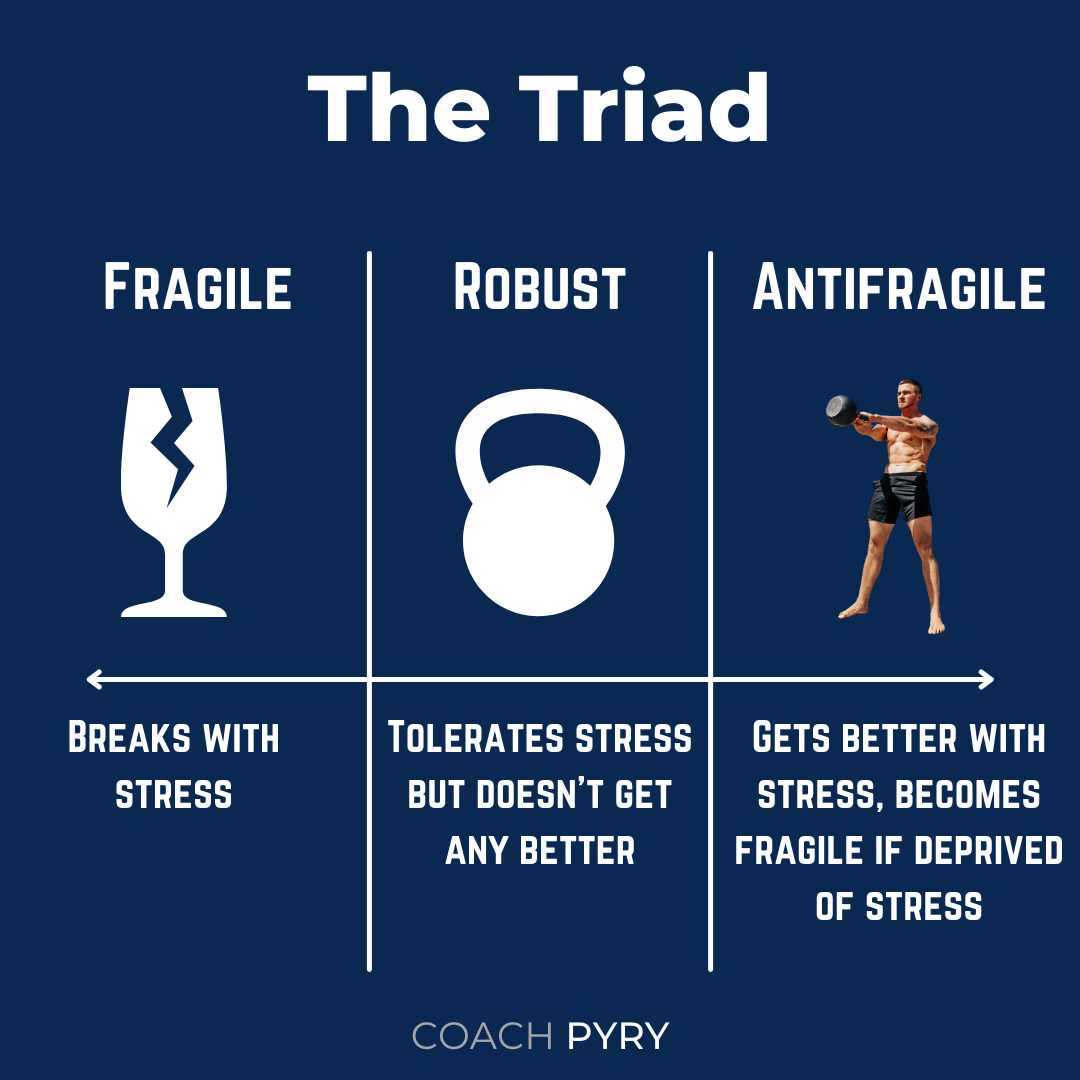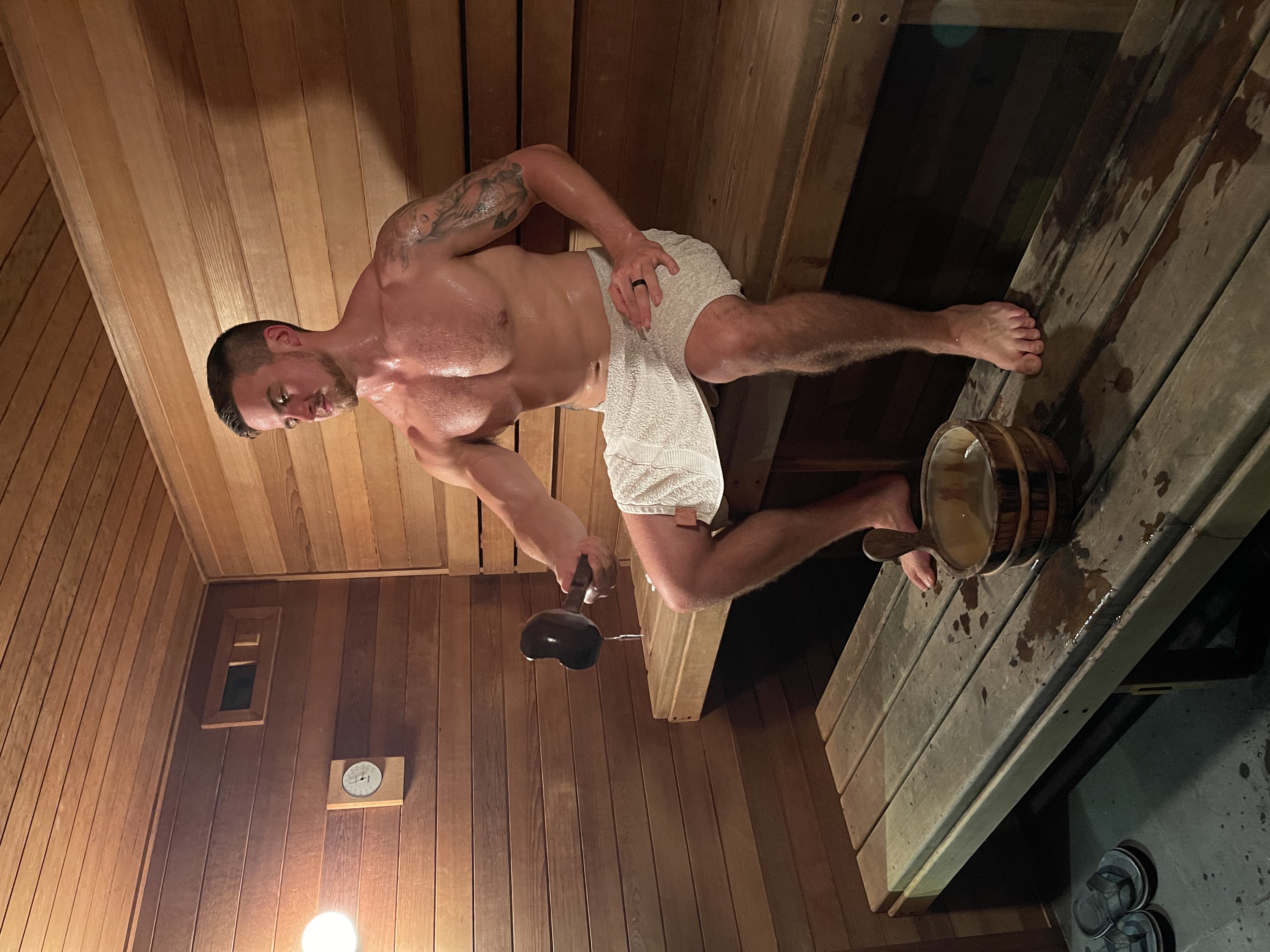Not All Stress Is Bad For You - How To Build Resilience
Sep 28, 2021
Not all stress is bad for you.
Frequently the word stress gets a bad rap. However, this is only half of the truth.
The reality is that stress is an integral part of life, and certain types of stressors are highly beneficial for our wellbeing and longevity.
In this blog post, you will learn what types of stress are essential for your wellness and performance and what you should avoid.
The Triad
Nicholas Nassim Taleb has proposed an excellent framework in his book Antifragile that illustrates how vital stress is.
He calls the framework the Triad. The Triad is the spectrum of fragility.
On the left is Fragile. Fragile things do not tolerate stress, disorder or randomness, and they break easily.
In the middle, there is Robust. Robust things tolerate stress, disorder and randomness well, but they do not get better with more stress.
On the right, we have Antifragile. Antifragile things get better with stress, disorder and randomness. Beyond that, antifragile things weaken and become more fragile if they are deprived of stress.

The Triad.
All biological organisms that have survived to this date, including you and me, are antifragile by nature. Mother Nature has chosen antifragility as her vehicle for moving forward.
We get better with stress.
When you go through a period of caloric restriction, your body becomes more efficient by destroying old and senile cells and replacing them with new efficient ones.
When you lift weights, you impose stress on your muscular tissues, connective tissues, the skeleton, and the nervous system. This stress is a stimulus for the body to create adaptations in case you decide to subject yourself to the pressure of resistance training in the future.
Suppose there are enough nutrients available, and the immune system isn't preoccupied with excessive inflammation elsewhere in the body. In that case, the immune system will get to work and repair your tissues to be stronger and larger than before you lifted weights.
In other words, our bodies evolved to get better by short-term stress followed by recovery. Stress that has a positive impact on the body is called eustress.
So why does stress get such a bad rap then if it's such an integral part of evolution itself?
The Mismatch
There is a mismatch between the type and magnitude of stress that our body has evolved to thrive under and the type and volume of stress we experience in our modern world.
What has changed?
1. Not enough eustress
Eustress is stress that has causes positive adaptations.
Most of us do not go through intense short term stress followed by long bouts of recovery. Caloric restriction, exercise and extreme temperatures, both hot and cold, are examples of stressors that activate the body's self-improvement mechanisms and are beneficial for us.
Sauna use is a form of eustress.
Physical activity is associated with reduced stress on workdays independent of age or gender, supporting the idea that the more you stress yourself voluntarily through physical activity, the less you will be distressed involuntarily by life circumstances. (1).
2. Too much distress
Distress is stress that causes negative adaptations.
The body doesn't know if the threat we perceive is real or imagined.
Our bodies do not differentiate between stress caused by a work deadline, someone flipping you off, a work deadline, or a lion chasing you. The body will always respond in the same way.
The response to all these scenarios is that the fight or flight state, also known as the sympathetic state of the autonomic nervous system, will be turned on.
There is nothing wrong with activating the fight or flight state. Being in that state makes us alert and provides us with immediate energy. It only becomes a problem if the fight or flight state is turned on too often or left on without conscious control.
To understand why this is the case, we will briefly review the autonomic nervous system and how it functions.

Modern-day lion chase. The problem is that your boss has a lot more stamina than a lion.
The Autonomic Nervous System
The autonomic nervous system is responsible for involuntary vital functions such as digestion, heart rate, blood pressure, breathing rate, hormone production, salivation, defecation and many other things.
The autonomic nervous system is subdivided into the sympathetic and parasympathetic states. The sympathetic is fight or flight, and the parasympathetic is rest and digest.
You can think of the sympathetic as the gas pedal and the parasympathetic as the brakes.
When you are in a state of rest and digest, the body prioritises reproduction and long term health.
This is when you digest food, your heart rate is low, blood pressure is low, breathing rate is slow, you produce sex hormones, and you might experience sexual arousal.
Rest and digest is also when you repair damaged tissues and build new stronger tissues that can take even more stress, muscles, for example. In essence, everything associated with your health, recovery and longevity is prioritised when you are in a state of rest and digest.
Existing in a state of rest and digest and only going into fight or flight occasionally when you exercise or run away from a lion is essential for our wellbeing and longevity.
When in fight or flight, your body prioritises immediate survival over reproduction and longevity.
When you are in fight or flight, heart rate increases, blood pressure increases and breathing rate increases, you stop digesting food, and blood is taken from the GI tract and shunted towards the limbs to fuel kicking, punching or running. Instead, you stop producing sex hormones and start producing stress hormones like cortisol and adrenaline.
In essence, everything that can improve your physical performance in the present moment is prioritised over your health in the future.
The analogy here is that you don't start mowing the lawn if a cyclone bears your house down. Why would you digest food if you had a lion chasing you? Let them do the digesting. (Hopefully not!)
Once again, the problem is not the stress response itself, and it only becomes a problem if the stress response is turned on too often or left on without conscious control.
Chronic fight or flight state activation is at the root of many chronic diseases rampant in modern society, such as cancers, dementia, obesity, and cardiovascular diseases.
The Barbell Approach To Stress Management
The barbell approach is another of Taleb's ideas, and it applies beautifully here.
A loaded barbell is empty in the middle, and there is weight in both ends of the barbell.
The barbell is analogous to your autonomic nervous system.
On the left, we have low arousal, the state of rest and digestion. This is where you should spend most of your time.
On the right, we have high arousal, the state of extreme fight or flight. This is where you will be when you exercise, go to the sauna, have a cold shower, or run away from a lion.
In the middle, we have chronic stress.
Be like a barbell, loaded in both ends and empty in the middle. Avoid the middle.

Avoid the middle.
You want to spend most of your existence in a state of low arousal, but you want to have the autonomic flexibility to get to a state of high arousal and do it quickly and smoothly.
Autonomic flexibility is a sign of a balanced nervous system. This rides along with low blood pressure, low resting heart rate, high heart rate variability, which are signs of good overall health.
People who are flexible in this regard have a high tolerance for physical and mental stress. You can sustain strenuous exercise without getting exhausted, and you find it easy to relax and achieve deep, high-quality sleep. You find it easy to build muscle and lose body fat.
Autonomic inflexibility means that you exist in the middle. Your resting heart rate is higher than average, and your breathing is fast and shallow, both during rest and exercise. You get exhausted quickly. Because you are chronically aroused, you will find it difficult to relax and fall asleep at night. It will be frustratingly hard to build muscle and lose body fat if you aren't recovering and sleeping.
How do you build autonomic flexibility?
How do you build a race car? Which comes first, the brakes or the engine? It would be best if you had both, but you have to put the brakes first. Bad things would happen if you drove your race car fast without brakes.
The body knows this, and it won't let you drive itself fast unless you first develop the braking system.
Deep, slow diaphragmatic breathing exercises are a direct and powerful way to install brakes into your body.
How you breathe at any point in time is a direct reflection of the arousal states of your nervous system.
Are you breathing fast and shallow? High arousal.
Are you breathing slow, light and deep? Low arousal.
You CAN control your breathing, and by definition, you CAN control your stress response via your breathing.
And when you calm down your breathing, your mind calms down too. When you shine the light of awareness to your breath, your mind goes quiet.
There is ample evidence suggesting that diaphragmatic breathing exercises are powerful acute and chronic stress management tools.
Diaphragmatic breathing reduces blood pressure and heart rate and increases heart rate variability, a measurement of stress tolerance and autonomic flexibility. Diaphragmatic breathing improves attention span and reduces negative emotions in healthy adults. (2,3)
This is why breathing is the First Pillar Of High Performance.
Breathing tools that reduce acute stress, activate a state of calm focus, improve sleep quality, and build autonomic flexibility are essential for your wellness and performance.
These tools and methods taught in the Breathing Foundations course can make everything else in your life more straightforward and effective, and the failure to use them makes everything else more complex and less effective than it could be.

Breath control is the foundation of wellness and performance.
Conclusion
You are an antifragile being. You get better with short term intense stress followed by recovery, and you become fragile if you are deprived of this kind of stress.
To thrive and enjoy your life to its fullest, you need autonomic flexibility.
You have to build the brakes first, and a fantastic way to do this is to incorporate diaphragmatic breathing exercises into your daily life.
Once you have the brakes, you can build the engine with progressive and intelligent strength and conditioning training. Train like a savage 3-4 times per week for 30-60 minutes. Adding some cold and hot exposure and periods of caloric restriction will make you even more antifragile.
If you want to learn more about stress tolerance and how you can objectively measure stress, listen to the newest episode of the Wellness and High Performance With Coach Pyry titled: "How To Become Antifragile".
Available on Apple Podcasts and Spotify.
Your friend and coach,
Coach Pyry
References:
Ready to unleash your potential through muscle building, strength, health and sustainable fat loss?
Get in touch via the form below, and we'll book your discovery call to map out your personalised plan to your best shape ever.


